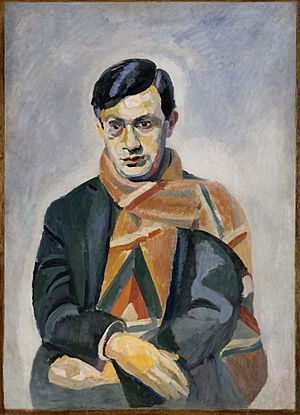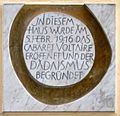Tristan Tzara facts for kids
Quick facts for kids
Tristan Tzara
|
|
|---|---|

Robert Delaunay's portrait of Tzara, 1923
|
|
| Born | Samuel (Samy) Rosenstock 28 April 1896 Moinești, Romania |
| Died | 25 December 1963 (aged 67) Paris, France |
| Pen name | S. Samyro, Tristan, Tristan Ruia, Tristan Țara, Tr. Tzara |
| Occupation | Poet, essayist, journalist, playwright, performance artist, composer, film director, politician, diplomat |
| Nationality | Romanian, French |
| Period | 1912–1963 |
| Genre | Lyric poetry, epic poetry, free verse, prose poetry, parody, satire, utopian fiction |
| Subject | Art criticism, literary criticism, social criticism |
| Literary movement | Symbolism Avant-garde Dada Surrealism |
Tristan Tzara (born Samuel or Samy Rosenstock; 28 April 1896 – 25 December 1963) was a famous Romanian and French writer and artist. He was a key figure in the avant-garde movement, especially known for helping to start and lead Dada. Dada was an art movement that challenged traditional ideas about art and society. Tzara was also a poet, essayist, journalist, and playwright. Later in his life, he became involved in politics, fighting against fascism and supporting communist ideas.
Contents
What's in a Name?
Tristan Tzara used different names throughout his life. His birth name was Samuel Rosenstock.
- He first used S. Samyro, which was a mix of letters from his real name.
- Later, around 1913, he signed some writings as Tristan Ruia.
- By 1915, he was simply using Tristan.
The name Tzara was added later. Some people say his friend Ion Vinea helped him choose it in 1915. Others believe Tzara was already using the full name, or variations like Tristan Țara, even earlier. In Romanian, trist în țară means "sad in the country," which some say was a hidden meaning behind his chosen name. He officially changed his name to Tristan Tzara in 1925.
Early Life and the Simbolul Magazine
Tristan Tzara was born in Moinești, a town in Romania. His family was Jewish, and his father was in the forestry business. Because of laws at the time, Jewish people in Romania didn't have full citizenship rights until after 1918.
When he was eleven, Tzara moved to Bucharest. In October 1912, at age sixteen, he started a magazine called Simbolul with his friends Ion Vinea and Marcel Janco. Even though they were young, they got famous writers to contribute to their magazine. Simbolul was important for bringing new, modern ideas to Romanian literature.
Moving to Switzerland and the Birth of Dada
Between 1914 and 1916, Tzara's career changed. He was against World War I and didn't like nationalism. In 1915, he published poems under the name Tristan Tzara in a short-lived journal called Chemarea.
In autumn 1915, he left Romania for Zürich, Switzerland, which was neutral during the war. His friends Marcel and Jules Janco were already there. Tzara studied mathematics and philosophy at the university but didn't finish. In Switzerland, he mostly stopped writing in Romanian and started writing in French.
In February 1916, Tzara joined German poet Hugo Ball and his wife Emmy Hennings at the Cabaret Voltaire. This was a place for performance art and exhibits. Tzara recited Romanian poetry and took part in "simultaneist verse" performances, where different poems were read at the same time.
It was in this creative environment that Dada was born. Dada was an art movement that aimed to shock people and challenge old ideas. Tzara's performances at the Cabaret Voltaire and other venues, along with his poems and art manifestos (public statements), became a main part of early Dada.
Dada's Rise and Challenges
Tzara became a key promoter and manager of Dada. He helped the group grow and set up branches in other European countries. He also started editing the Dada periodical, which was very popular.
Dada artists, including Tzara, rejected the ideas of Italian Futurists, especially their support for war. Dada became a leading movement in modern art. Tzara also connected with other artists and writers, like Giorgio de Chirico and German Expressionists.
The Dada shows in Zürich often caused scandals. Tzara enjoyed shocking the public. In 1918, he published his first book of poems, Vingt-cinq poèmes ("Twenty-five Poems").
After World War I ended, Dada continued to evolve. Tzara, along with artists like Jean Arp, tried to spread Dada's ideas in a world that was dealing with big political changes, like the rise of communism.
Paris Dada and New Conflicts
In late 1919, Tristan Tzara moved to Paris, France. He joined other writers like André Breton in editing the magazine Littérature. In Paris, Tzara was seen as a leader in the avant-garde art scene. He continued to publish his Dada magazine, renaming it Bulletin Dada and later Dadaphone.
Dada performances in Paris were often meant to get attention through hoaxes and false advertisements. For example, they once announced that movie star Charlie Chaplin would appear on stage. These events often ended in chaos. In March 1920, a show at the Théâtre de l'Œuvre featured readings and a musical piece by Tzara that involved people shouting. This led to a scandal when Breton read a "Cannibal Manifesto" that insulted the audience, causing them to throw rotten fruit at the stage.
By 1921, conflicts started to appear within the Dada movement. Tzara argued with other Dadaists, including André Breton, who felt that Dada was repeating itself. In May 1922, Dada even staged its own "funeral," suggesting the movement was ending. Tzara declared that "Dada is useless, like everything else in life."
A major event happened in July 1923, during an event called Evening of the Bearded Heart. Tzara presented his play The Gas Heart. Breton interrupted the performance, leading to a fight and a riot that police had to stop. After this, Dada's importance declined.
Moving Towards Surrealism
After Dada ended, Tzara continued to write. In 1924, he published and staged the play Handkerchief of Clouds. He also collected his earlier Dada writings in Seven Dada Manifestos.
In 1925, Tristan Tzara married Swedish artist and poet Greta Knutson in Stockholm. They had a son named Christophe in 1927. Around this time, Tzara had a house built in Paris by the famous architect Adolf Loos. The house was known for its simple, modern design and its collection of African art.
In 1929, Tzara and André Breton made up, and Tzara started attending Surrealist meetings. Surrealism was a new art movement that grew out of Dada, focusing on dreams and the subconscious. Tzara published important poetry books during this time, including The Approximate Man (1931), which is considered one of his most important works.
Political Involvement and World War II
As Adolf Hitler and the Nazi regime rose to power, Tzara became very concerned. He started to combine his art with the fight against fascism. He became close to the French Communist Party.
When the Spanish Civil War broke out, he went to Spain to support the Republican forces. He visited Madrid while it was under attack and later published poems about his experiences.
During World War II, Tzara hid from the German occupation forces in southern France. He joined a group of anti-fascist and Jewish refugees trying to escape Nazi-controlled Europe. Later, he joined the French Resistance, fighting against the Germans. He contributed to Resistance magazines and worked for a secret radio station. His son, Christophe, also joined the Resistance.
In 1942, because of anti-Jewish laws in Romania, Tzara lost his Romanian citizenship. After the war, he became a French citizen. In 1945, he even served as a representative in the National Assembly. In 1947, he became a full member of the French Communist Party.
Later Years and Legacy
In the years after the war, Tzara continued to support political causes, including decolonization (countries gaining independence from colonial rule). He visited Eastern European countries, including Romania, and spoke about communist ideas.
His later works included poetry collections like Le Signe de vie ("Sign of Life", 1946) and De mémoire d'homme ("From a Man's Memory", 1950). He also helped stage Samuel Beckett's famous play Waiting for Godot and translated poems by other writers.
In 1956, Tzara visited Hungary and supported the Hungarian people's desire for more freedom from Soviet control. This caused some disagreement with his own Communist Party in France.
He spent his final years researching the work of a 15th-century poet named François Villon and promoting African art. In 1961, he received the prestigious Taormina Prize for his poetry. Tristan Tzara died in Paris in 1963 and was buried in the Cimetière du Montparnasse.
His Impact and Legacy
Tristan Tzara influenced many writers and artists after him. His ideas helped shape movements like the Beat Generation in the United States and even influenced rock music.
- He is seen as a key figure leading to the Theater of the Absurd, and playwright Eugène Ionesco looked up to him.
- His poetry influenced Samuel Beckett, who translated some of his works.
- Beat writers like Allen Ginsberg and William S. Burroughs were inspired by Tzara's ideas, especially his use of chance in writing.
- Modern artists and musicians, including Radiohead and DJ Spooky, have also been influenced by his avant-garde approach.
Tzara's life and work have been featured in books, plays, and films. He even appears as a character in Tom Stoppard's play Travesties, where he is imagined playing chess with Vladimir Lenin and James Joyce. Many artists, including Robert Delaunay and Pablo Picasso, created portraits of him. In 1996, Romania honored him with a series of stamps and a monument in his hometown of Moinești.
Images for kids
-
Tzara (second from right) in the 1920s, with Margaret C. Anderson, Jane Heap, and John Rodker
-
Theo van Doesburg's poster for a Dada soirée (ca.1923)
-
Maison Tzara, designed by Adolf Loos
-
One of Guillaume Apollinaire's calligrams, shaped like the Eiffel Tower
See also
 In Spanish: Tristan Tzara para niños
In Spanish: Tristan Tzara para niños











